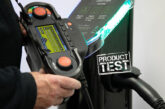
PE Product Tester Gary Fisher gets acquainted with the Defender range of metal consumer units from Contactum.
So the 1st January has been and gone and now, in compliance with regulation 421.1.201 in Amendment 3 to BS7671 IET Wiring Regulations, we are required to fit consumer units manufactured from non-combustible materials in domestic premises.
While I was initially sceptical of the regulation, I’ve actually found that the cost of most metal distribution boards aren’t that different to the plastic versions and with some wholesalers you might get a better deal for a fully loaded type. OK, they may take a little longer to install depending on where all the cables are coming from but only time will tell if this is the correct way forward.
There are some very good metal consumer units on the market, and one that I’ve found particularly pleasant to work with is the new range from Contactum.
There are 12 models within the Defender range in different sizes and combinations to suit almost all applications you could encounter in a domestic installation. The use of a mixture of circuit breakers, RCD switches and, of course, RCBO safety devices give you even more variety of choice.
The unit I have is a typical 10-way twin RCD fully loaded type complete with main switch and all internal link cables.
“There are some very good metal consumer units on the market, and one that I’ve found particularly pleasant to work with is the new range from Contactum.”
The first thing you will notice is that they look good. After all, clients don’t want to see some horrible metallic looking board on their walls, whether it’s in plain sight or not. The Defender range is off-white, plain and subtle.
As with all metal consumer units my main concern is how am I going to position the cables. The Defender has a number of cable entry knockouts located along the top and bottom edge as well as a couple of larger knockouts located to either side, which are handy for bringing in the main tail connections. Installation would require an appropriate gland kit, which unfortunately you do have to purchase separately.
Of course if the cables enter from the back there are three substantial knockout points to help in this method too. Once inside the board there is plenty of room for all the cables to be terminated into their appointed connection bars, with PCs and neutrals all nicely situated along the top edge.
Clear identification is also easy to achieve. There is plenty of room beneath the circuit ways to provide all necessary labels, (more than most other types of boards I have used in the past), so there is no excuse for not identifying each circuit way clearly.
Overall, when the Defender is completely installed, it looks really smart. It’s great to see such an easy to install, British made range available in such a wide variety of sizes. I would certainly recommend this as a strong addition to the metal consumer units hitting the market at the moment.








